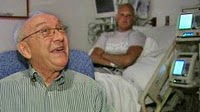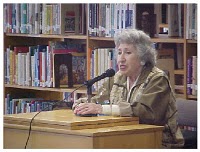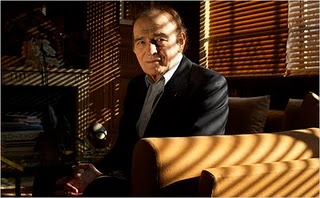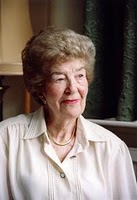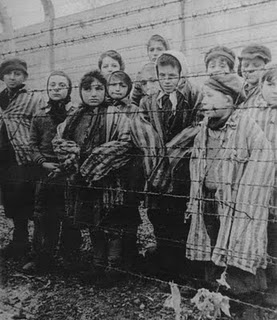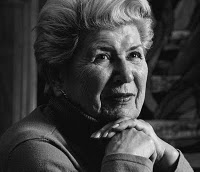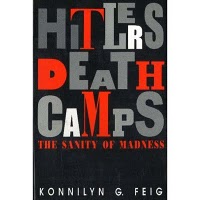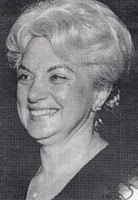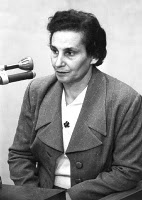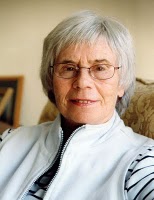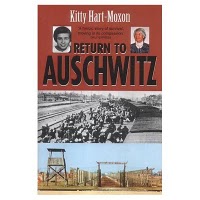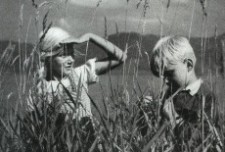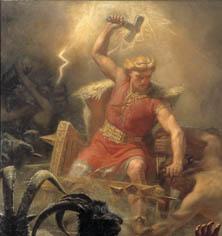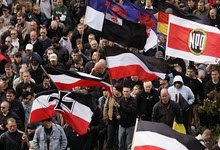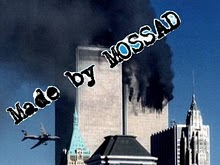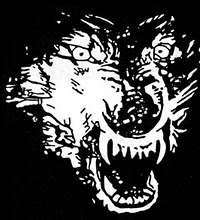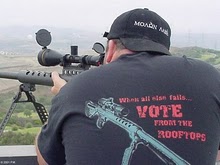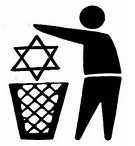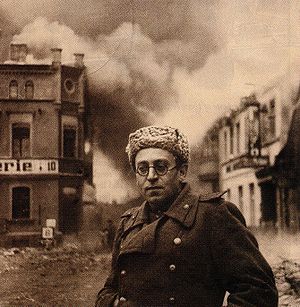 Vasily Grossman with the Red Army in Schwerin, Germany (1945) [1]
Vasily Grossman with the Red Army in Schwerin, Germany (1945) [1]Jewish author Vasily Grossman wrote fiction novels in Soviet Russia prior to the war, keening the imaginative faculties of his mind. During WWII he was a "reporter" for the Soviet Army. His article "The Hell of Treblinka" (1944) was disseminated at the Nuremberg War Crimes Tribunal as evidence for the prosecution. Grossman was considered a "war hero" by the Soviets for his writings. [1]
Among other things, Vasily claims "3 million" people were exterminated in the "death factory" of Treblinka over the course of 13 months, "engine gas" and "steam chambers" were used as a means of extermination, that giant machines were used to excavate large pits at Treblinka for the disposal of the bodies, and that Himmler visited Treblinka in 1943 and ordered that the bodies in the pits be dug up and burned to destroy the evidence of extermination.
So "several million" corpses were dug up from the giant pits and burned on specially designed giant outdoor ovens. There were 3 ovens, each over 250 yards long that could burn around 4000 bodies at a time. Vasily claims "eyewitnesses" reported that the flames leaping off the giant hibachis reached 25-30 feet into the air, and that the flames could be seen "30 to 40 miles" from the camp. Then the ashes were disposed by spreading in fields and roads.
Also included in Vasily's fable are the stories of sending jew hair to Germany to make ropes for submarines and to stuff mattresses, dead bodies "writhing" in the fires, the bellies of dead pregnant women bursting in the fires, and of "monstrous" Germans "leisurely entertaining" themselves by burning children.
What could have possibly inspired a tale of this sort? Perhaps Vasily toured the very real destruction and mass murder his jewish brothers and partners in crime, the Bolsheviks, had unleashed on the Russians, Ukranians, and others.
The article also describes an uprising by the prisoners in which a rag tag group of half-starved inmates with axes, knives, and batons defeated several hundred SS guards and the camp was burned down. Then the Germans - with the Red Army advancing towards Germany - supposedly devoted manpower to totally destroy the camp, blowing up the buildings, etc in order to cover up the evidence. Convenient cover story for the Soviets...don't bother looking for the evidence to substantiate the claims of Vasily or the other "eyewitnesses."
The article reads like war propaganda from tabloid writers. The Germans are sophomorically demonized as "monsters" and "sub-humans", while Comrade Stalin and the "Holy Soviet Army" is fighting for freedom against the "Hellish Germans."
Full article "The Hell of Treblinka" in French:
http://www.memoire-juive.org/treblinka.htm
Notable excerpts from the article (using Google translate):
The Hell of Treblinka
by Vasily Grossman, unabridged French version
The headings are not Vasily Grossman; they have been added for better navigation in the text.
[...]
Today the men spoke, stones and earth have borne witness. And we, in the eyes of humanity and to the conscience of the world, go one after the other circles of hell Treblinka, which pales to the hell of Dante. Everything you read, I have reconstructed from the stories of living witnesses, statements of men who worked at Treblinka since its inception until August 2, 1943, the day that death row inmates revolted, burned the camp and fled into the woods. The prisoners confirmed word for word the statements of witnesses and sometimes supplemented. All these men I saw with my own eyes I have talked at length, have before me their written statements. Such testimony, however, different sources, are perfectly aligned, whether Bari, head of the dog camp, or the technique of mass murder, the organization murder in the chain. Therefore we commit in the successive circles of Hell of Treblinka.
[...]
The women's hair
In the women's barracks, there was a "salon" where they are going to the mower, the old one removed their wigs. Strange psychological moment: the testimony of hairdressers, by being stripped of their hair, women were convinced they were going to the bath. Sometimes one of them stroking its head said: "Here a little shorter, please ... Equalizing ...Almost all came out reassured with a piece of soap and a towel, but young people regretted their beautiful tresses. Why do we cut their hair for women? Was it to deceive?... No, it was for use as raw material ...I asked many people what the Germans did all the hair of those who would die. They said that huge pile of curls and braids black or golden blonde, were disinfected, pressed in bags and shipped to Germany. Eyewitnesses confirmed that the bags were in fact German addresses. But there, that was one of those hair? Nobody could answer me. A Kon, in his written statement, said they were in the Department of the Navy, they used to stuff mattresses, plaiting ropes for submarines, etc..
[...]
The gas chamber
Before them stood a handsome stone building with wooden ornaments and was thinking of an ancient temple. Concreted Five steps led to the low doors, but very large, massive and beautiful work. Flowers grew outside the entrance that large decorated vases. 'But all around was chaos: they were everywhere from the mountains of freshly turned earth; his claws of steel, a great excavator projected grating in tons of yellow sand and dust was made as a curtain dimming the sun. The roar of the gigantic machine that all day digging huge graves mingled the furious barking of dozens of dogs-wolves.
[...]
Attempt to assess the number of victims
Each room of the new building was eight meters long and seven wide, that is to say fifty-six meters square area. Their total area was then five hundred yards square, counting seventy-five square meters of the three rooms at the beginning, Treblinka had an industrial area of death of six hundred thirty-five meters square. We piled in one room of four hundred to five hundred people. Therefore, when the ten rooms were operating at full, they annihilated at a time about four thousand five hundred people. On average, Chambers of Hell of Treblinka were filled two or three times a day (but sometimes up to five times). That is to say, it perished, that nothing in the new rooms, assuming what not were filled twice daily that is to say reducing the numbers, about ten thousand people per day three hundred thousand per month. For thirteen months, Treblinka worked all day. Even if we assume ninety days off for repairs or because there were no trains, there are still ten months. At the rate of three hundred thousand victims per month on average, we get for ten months, the appalling figure of three million, he confirms. our conjectures early: three million, we said, basing our calculations on the number - in fact deliberately reduced convoys arrived. I summarize:
Firstly, witnesses say, Treblinka worked every day in spite of their habits, the Germans were resting or Sunday or even on holidays such as Christmas, Easter or New Year.
Secondly, the number of cargo room - which had Treblinka most notorious of all the factories of death - was higher than we gave. It happened because we entassât in each seven hundred to eight hundred and even people. Usually they threw children and low over the heads of adults literally pressed against each other.
Third: I added that this happened twice a day when everything suggests that the average time was three. So even in greatly reducing all figures - whether convoys arriving at Treblinka or the number of killed per room - we get the fabulous figure, the monstrous figure of three million exterminated in thirteen month!
The death in gas chambers
The death occurred after ten to twenty minutes. The first time, when new rooms were "put into operation" and that the executioners, having not yet developed their system, were engaged in experiments to assay the Victims subjected to horrific suffering did not die until two or three hours. At first the crowds and suction equipment malfunctioning, death occurs after eight to ten hours of torment. Different methods were tested. The first was the repression of gas engine exhaust of a heavy tank towards the needs of the Treblinka station. The gas containing 2 to 3% carbon monoxide, which has the property to set the blood hemoglobin to give a durable combination.
[...]
There was a third method, less used, but used it anyway. It was to remove the air chambers through the steam. The principle does not change: it was to deprive the body of oxygen.
[...]
After twenty minutes
After twenty to twenty-five minutes, the acolytes of Schmidt threw a glance through the peephole. The time had come to open the doors that opened onto the quays. Detainees, in combination, closely followed by the SS, proceeded to "clean". As the floor was bowing to the dock, many corpses rolled from there themselves. Those who worked in "clean" room told me that the faces of the dead were frankly yellow and 70% had blood on the mouth and nose. For physiologists to explain it. The SS, while chatting, examined the bodies. If someone was still alive, moaning or moving, we finished a shot. Then teams armed with dental forceps tore the dead their teeth with gold or platinum. These were sorted and shipped to Germany in crates. If it had been better or more convenient to pull teeth to live the SS would not hesitate to do so, but it was easier and simpler to operate on cadavers.
[...]
The great excavators worked ceaselessly, day and night digging pits new long several hundred meters, which we did not see the bottom. The pits were open, waiting, but not for long.
[...]
II
The minister of death
In the late winter of 1943, Himmler arrived by plane at Treblinka, along with a large following officials of the Gestapo. The group landed near the camp where he went on two cars through the main entrance. Most new arrivals were in uniform, but some may be experts, were civilians in coat and hat. Himmler inspected the camp, and one of those who have seen tells us that the minister's death came a huge pit and gazed in silence, while those who accompanied him were held back at some distance from this monumental tomb already half full of corpses: Treblinka was the company's largest Konzern Himmler. The Reichsführer SS said the plane that day, but after giving the command of the camp an order which perplexed and Hauptsturmführer Baron von Pfein, Korol and his deputy, and Captain Franz had to proceed without delay to the excavation of corpses, burning them all to the last, and spread the ashes in the fields and roads. There were already several million in land, the task was therefore more difficult. In addition, we would never bury the dead they had to burn.
But why travel Himmler's orders and these categories? It's simple: the Red Army had conquered Stalingrad. It was a terrible blow for the Germans, and for the first time Berlin began to consider the liabilities incurred, punishment, expiation. This explains the arrival at Treblinka Himmler himself and he gave the order to remove at the earliest traces of the crimes perpetrated at sixty kilometers from Warsaw. Yes, this was the result of the Russian victory in the Battle of the Volga.
The decision to build crematoria
Himmler said: "Incinerate all dead. ""
But the bodies burned badly (those women, it is true, were consumed more than others), and it took a lot of fuel and plenty of oil. The company was expensive. In sum, there was an impasse. But a specialist arrived from Germany, a burly SS that bordered the fifties. The Hitler regime has produced specialists! And of all kinds for the murder of small children, strangulation, for the construction of gas chambers and destruction, scientifically organized, large cities within a day. There was one also for the exhumation and burning fast millions of corpses.
He came to Treblinka and directed the construction of furnaces. Furnaces of a particular type, as neither the crematorium in Lublin, or any other, had been able to burn at a time so short that amount of body. An excavator dug a long pit of two hundred fifty three hundred yards, wide from twenty to twenty-five meters, five meters deep. Three rows of small equidistant columns of reinforced concrete, high hundred to one hundred twenty centimeters, were built at the bottom and served to support steel beams that are arranged along the length of the pit. On these girders, and transversely, was installed rails, Cinq-seven centimeters from each other. We thus had the gates of a giant cyclopean oven. A new narrow gauge line of graves led to the first oven, which he would soon added a second and a third of the same dimensions. Each could receive both of three thousand five hundred to four thousand corpses.
Thick columns of smoke
They sent a second "Bagger" - giant excavator - then another. We worked night and day. Those who were engaged for the incineration of corpses say that the ovens were thinking of amazing volcanoes, the heat they gave off a terrible burnt faces; they vomited flame reached eight to ten meters; columns of black smoke dense and oily, rose into the sky and displayed in a heavy curtain move. Thirty or forty miles around, the villagers saw the flames rising in the night above the fir forest surrounding the camp. The smell of burned flesh was everywhere. When the wind blew towards the Polish camp, located three kilometers away, the air was stifling. The incineration of corpses occupied eight hundred prisoners, many more than that of workers employed in the blast furnace or hearth of any large metallurgical plant. For eight months, this monstrous company worked night and day, but without arriving to remove all the bodies buried there. It is true that new quotas on death row still arriving. Hence, for furnaces, extra work.
The horror
They came from Bulgaria, and that SS sentry waited impatiently. For deceived by the Germans and the fascist Bulgarian government then, these people ignorant of the fate that awaited them, brought with them many objects of value, excellent food, white bread. They came from Grodno and Bialystok, Warsaw Ghetto, which had raised, he had also other points of Poland were soldiers, workers and peasants Polish insurgents. A contingent of gypsies came from Bessarabia: about two hundred and eight hundred men, women and children. They had made the journey on foot, followed by their trailers, they had been deceived, too, and that they were escorted by two guards who were unaware that these people were going to die. It is reported that the Bohemians clapped their hands in admiration at the beautiful building of gas chambers, without guessing until the last moment the fate that awaited them, and that greatly amused the Germans. The SS cruelly raged against the rebels of the Warsaw ghetto. They put aside women and children, they led not to the gas chambers, but where the burned corpses. They forced the mad mothers with horror to drive their children from the ovens where thousands of bodies writhing in the flames and smoke, where the corpses, such as living agitated and contracted, where the bellies of dead pregnant burst under the effect of heat where children killed before birth, burning in the gaping womb of their mothers. This vision that would withstand the punishment due to man's most hardened would have a hundred times more terrible about these women who tried to cover their hands in front of their terrified children, "Mommy, what's that we'll we do? Are we going to burn us? "They shouted, pressing against them ... Dante in his Inferno, had seen anything so awful. After leisurely entertained by the spectacle, the Germans burned children.
Why write this?
One feels in reading all this a sense of unbearable horror. But the reader can believe me, writing is no less painful. You may say perhaps: "But yes what you require? Why portray these monstrous pictures? ""
Because even when it is terrible, the writer must tell the truth, and the reader must know it. Turn away, ignore, ignore, is an insult to the memory of those who perished. Who knows the truth, the whole truth will never be known with any enemy, what with our big monster, our Holy Red Army had started a fight to death.
Hymn of Treblinka
The "hospital", too, was refurbished. The first time they brought the sick in space delimited by the branches. After being greeted by a fake "doctor", they were killed and their bodies placed on stretchers were taken to the grave. Then they dug a large circular pit. All around, the seats were arranged very low, but so close to the board that there was one sitting on top of the pit where the bodies burning. It led to the "hospital" sick and decrepit old men, the "nurses" made them sit on seats when they saw the bodies writhing in the fire, then these sadistic fired at close range in the necks and gray arched backs, and poor body swooped down in flames.
We knew all the weight of German humor, which we never had a very high opinion. But how could we have imagined what was in Treblinka humor, entertainment, jokes SS?
They organized football matches between those sentenced to death, they forced them to play hide and seek, they organized choirs and dances which these unfortunates were to take part. Near German barracks, there was a menagerie of beasts relatively harmless, wolves and foxes, were locked in cages, while the wild beasts the most hideous and dangerous that the world has ever brought to and fro in freedom, and listening to music sitting on benches birch. A hymn called Treblinka had been made for death row:Für uns heute nur giebt Treblinka
Das ist unser Schicksal
(Nothing that Treblinka
It is our destiny. )
They forced the men to bloody repeat chorus a few minutes before their death, silly songs, sentimental... Ich brach das Blümelein
schenkt und es dem schönsten
Geliebten Madlein ...
(I picked the little flower
And I offered my beautiful ... )
One day the commander had withdrawn a batch of new arrivals a few children whose parents were killed, he ordered them to dress in nice clothes, feed them sweets, and he played with them. But this fad passed him after a few days, after which he was killed.
One of the main entertainment of the SS, was to suffer the worst violence to women young and pretty as we begin to share each new arrival and that their torturers themselves pushing the next morning, the gas chamber. So fun to Treblinka those support the Hitler regime, the pride of Nazi Germany.
[...]
The deportees who worked at the incineration
Summer 1943 was exceptionally warm. Not a drop of rain, not a cloud, not a breath of wind for weeks. The incineration of corpses continued; six months already since the furnaces were operating day and night, but only just over half the dead were burned.
Inmates who worked in the incineration of corpses could not long resist the horrible moral and physical torments they endured, were recorded from fifteen to twenty suicides per day, and many were killed in deliberate breaching disciplinary rules.
"Receiving a ball was a luxury," said Kossow a guy who escaped from the camp. And they told me that being sentenced to life in Treblinka was a thousand times more horrible than to die.
Ash
It carried the ashes out of the enclosure. Villagers Wolke, mobilized by the Germans loaded them into cars and spreaders on the road, along the side of death, led to the disciplinary camp of Polish, and extended the children held regularly on this road using shovels. They were sometimes of gold coins, gold teeth melted. 'Children of the dark road, "they said in speaking of them. Indeed, it was black and ash like a ribbon of mourning. The wheel of cars there was a sound 'very special, and when I followed, I thought I ever heard a rustle plaintive and deaf as a timid moan.
This black ribbon, through woods and fields, was the death camp in the Polish camp, was a symbol of the terrible fate that united the people under the ax of Hitler's Germany.
The peasants carried the ash from spring 1943 to summer 1944. Every day, twenty cars were going to work and each carried six or eight times a load of one hundred twenty-five to one hundred and thirty pounds.
[...]
The end of Treblinka
Treblinka had ceased to exist. The Germans incinérèrent the corpses still remained, demolished buildings of brick, removed the barbed wire, burned what remained of the wooden huts. They blew up or carried facilities, did disappear ovens, retired excavators, filled the innumerable ditches. Nothing remained of the station building. Finally they dismantled the track, removed the tie. They sowed the lupine on the location of the camp, and some Streben it built a small house. Today it is more: it was also burned.
What was the purpose of the Germans? Hide the footsteps of millions of murders in the hell of Treblinka? But they thought it was really possible? They hoped to close the mouth for thousands of witnesses who saw the doomed trains, from all parts of Europe, moving towards the factory of death? Obscure the macabre heavy flame, smoke during eight months climbed into the sky and saw that night and day the residents of dozens of towns and villages? Remove thirteen months of horrible cries pushed by women and children, and that farmers have Wolke still hear? To silence the peasants for a year were transported human ashes from the camp on nearby roads? Forcing to silence those who have seen and which provide precise and consistent evidence on each SS, each sentry, who can not rebuild step, hour by hour, the newspaper of Treblinka? To them no one will cry over "Mützen ab! "Nobody crammed into gas chambers. Himmler has more power over his followers who, head down and pulling their fingers trembling on the edge of their jackets, trace a voice dull and monotonous history of their crimes they believe caused by the folly or delirium. A Soviet officer who carries the green ribbon of the Medal of Stalingrad records the confession of the assassins. The tight-lipped guard who stands at the door, too, the Medal of Stalingrad, his thin face, tanned by the winds, is serious and severe. This is the very face of the people's justice. The symbol is not striking? It is a victorious army at Stalingrad who came to Treblinka, near Warsaw. If Heinrich Himmler was moved in February 1943, he came by plane to Treblinka, he gave orders to build kilns to burn the corpses, to remove the traces, it was not without reason. But it was fruitless. Defenders of Stalingrad arrived at Treblinka: the road from the Volga to the Vistula was short. Today, the soil of Treblinka refuses to be complicit in the crimes perpetrated by these monsters: he vomits bones, objects that belonged to the dead and that Hitler had wanted to hide.
Treblinka, September 1944
We arrived at the Treblinka camp in early September, thirteen months after the uprising. The death factory operated thirteen months and thirteen months the Germans have been working to erase the traces.
Everything is quiet. Just when one hears the rustle of pine summit, along the railway. These pines, sand, the old stock, millions of eyes have looked at cars that were advancing slowly toward the dock. Means crunching softly ash, slag powder on the dark road, lined with carefully, like German, stones painted white. We enter the camp, we tread the soil of Treblinka. The lupine pods crack as they are touched with a slight tingling and millions of seeds are spread on the ground. The noise they are falling and the pods are opening that are based in a sad, sweet melody, as if we came from the depths of the earth - far, wide and melancholy - the death knell of small bells. The land undulates beneath the feet, soft and greasy as if it had been sprinkled with flaxseed oil - earth bottomless Treblinka, surging like a sea That wilderness surrounded with barbed wire has engulfed more human lives than all oceans and seas all over the globe since the human race exists.
Land rejects bone fragments, teeth, various articles and papers. She will not be complicit.
Things escape from the ground splits, its wounds still gaping shirts half consumed, panties, shoes, cigar-greenish, wheels of watches, pocket knives, shaving brushes, candles, slippers for children Red pompoms, serviettes of Ukraine, lace, scissors, thimbles, corsets, bandages. Further heaps utensils: drums, aluminum cups, pots, pans, pots, jars, cans, canteens, cups child Ebonite ... Still further, a hand appears to have derived from the land of bloated Soviet passports, half charred, and log books in Bulgarian, photographs of children from Warsaw and Vienna, childish letters, poems written on the yellow sheet of a book of hours, ration cards in Germany ... And everywhere, perfume bottles, green, blue or pink ... A horrible odor of decomposition prevails in these places, which nothing could overcome neither the heat nor sun, nor rain, nor snow, nor wind. And these things have become prey swarms of gnats.
We continue to move forward on this land where not sink when suddenly we stopped. Hair thick, wavy, copper-colored, fine hair girls trampled, then curls, braids heavy black on the white sand, and others more. The contents of a bag, one bag of hair, had spread there ... So it was true! Hope, a wild hope, collapsed: it was not a dream! The pods of lupine continue to make clear, their seeds fall, and one would always hear rising from beneath the earth knell of an infinite number of small bells. It seems that the heart will stop beating, contracted by bitterness, pain, anguish too strong.
Racism, a mortal danger to mankind
Scientists, sociologists, criminologists, psychiatrists, philosophers ask how this could happen. Should we seek the cause in some organic traits, heredity, education, environment, external conditions, a historical inevitability, the criminal intent of directors? Embryos of racism, which seemed so funny, presentations by teachers and charlatans indigent theorists steeple in Germany in the last century, the German philistine contempt for the Russian, Polish, Jewish, the French, the English, Greek, Czech, this overweening belief, all free of German superiority over other peoples, quietly mocked by comedians and publicists, all suddenly, within a few years, has deprived his features "childish" and grown into a mortal danger to humanity, life and freedom, all this has been a source of incredible suffering, has shed rivers of blood and increased the crime, certainly, there is food for thought!
Every citizen of the world meets the future
Wars like this are horrible. But it's too little today about the responsibility of Germany. Let us be clear that all peoples, that each citizen of the world meets the future.
Today everyone is bound to his conscience, before his son and to his mother before his country and to humanity, to answer all his soul and his whole thought to the question: where does Racism? What does it take for the Nazis, Hitler never did reappear, or one side or the other of the ocean?
The imperial idea of "superiority" of national, racial, etc.., Has consistently led the Nazis to create camps of Majdanek, Sobibor, Bełżyce, Oswiencim, Treblinka.
Do not forget that this war the fascists will not lose the bitterness of defeat, but also the sensual memories of mass killings carried out easily.
That is what must be remembered, fiercely, day after day, those who hold dear the honor, freedom and life of all peoples, of all humanity.
Vasily Grossman
NOTES
(1) It was here the first attempts to calculate the number of victims of Treblinka. Today, an estimated more than 700,000 around the number of Jews exterminated in this camp. General Commission of Inquiry concluded that 731,600 people, Jews, Poles and Gypsies murdered. (The German Crimes in Poland, Warsaw, 1948). The figure of 700,000 is included in an article, The indictment of the trial of Treblinka (Le Monde Juif, Revue du CDJC, July 1966). Raul Hilberg speaks of 750,000 Jews and more than 800,000 casualties in total.
And now for the truth about Treblinka...
Over six days in October of 1999, Australian scientists conducted a detailed forensic examination of the soil at the site, including the use of ground penetrating radar, and found absolutely no evidence whatsoever of any mass graves ever existing there.
Apparantly the Germans dug up the ash and remains of "several million" corpses and transported the remains elsewhere, and then replaced the soils with such efficiency that modern technology could not detect the soil strata had ever been disturbed.
